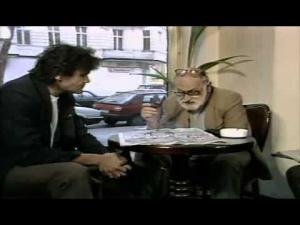MOUTH AGAINST THE SCREEN
Peggy Ahwesh, John Berger & Mike Dibb, Theresa Hak Kyung Cha, Harun Farocki, Richard Serra & Carlota Fay Schoolman, Pola Weiss
September 8, 2023
Program curated by Sarah Grace Faulk and organized by Aurora San Miguel.
The program for this screening is a product of research related to a media arts course taught by Sarah Grace Faulk in the summer of 2023, and a longtime friendship with Aurora San Miguel. The course took the porosity of the category of media art as its primary object, working with a range of artworks to conduct an investigation into the relationship that art holds with the emergence of new technology and the social world.
Ways of Seeing (1972), John Berger & Mike Dibb, 30:03
Before it was the singularly popular publication of art history for the mainstream, “Ways of Seeing” was a four-part series aired on BBC. In its attention to and experimentation with the format of transmission broadcast, “Ways of Seeing” asks audiences to consider their experience of sight in the age of mechanical reproduction.
Television Delivers People (1973), Richard Serra & Carlota Fay Schoolman, 06:00
This work was also broadcast on television, and represents an attempt to inter- vene upon the structure of consumption endemic to television, via experimental video art. This attempt is a didactic play with the aesthetics of television that asserts, “It is the consumer who is consumed.”
Mouth to Mouth (1975), Theresa Hak Kyung Cha, 8:00
Cha’s video-poem of language in the void comes from a rich conceptual practice informed by French psychoanalytic cinema, linguistic theory of the 1970s, and her own experience of exile and displacement. While best known for her book, Dictée (1982), “Mouth to Mouth” represents a stunning extension of Cha’s theoretical work into the video form.
Catch Images: A Conversation with Vilem Flusser (1985), Harun Farocki, 12:38
Flusser was a media philosopher who recently enjoyed wider recognition for how his work uniquely theorized media as the complex and over-integrated force it has become. This conversation with the filmmaker Harun Farocki represents some of Flusser’s ideas in action.
Ejercicio con Mo (1985), Pola Weiss, 10:53
Credited as the pioneer of video art in Mexico, Weiss was also early to experiment with the merging of dance and video, becoming a pioneer in what is now known as screendance. “Ejercicio Con Mo” is a collage of sound, images, bodies, and spaces; the effect is visceral, like a highly visual fever dream.
She Puppet (2001), Peggy Ahwesh, 15:14
The aesthetic expectations of watching someone else play a video game have proliferated to the point that “She Puppet” retroactively joins its canon. This collection of footage from months of playing Tomb Raider is edited together with quotes from “The Book of Disquiet,” by Fernando Pessoa, “The Female Man,” by Joanna Russ, and Sun Ra.
Our techno-imagination is underdeveloped, because we dare not decipher the techno-images correctly. We prefer to collaborate with the apparatus that programs us, instead of facing the fact that our values are no longer appropriate to the world we live in.”
– Vilém Flusser
Theresa Hak Kyung Cha
Mouth to Mouth, 1975
Still from video
Richard Serra & Carlota Fay Schoolman
Television Delivers People, 1973
Still from video
Harun Farocki
Catch Images: A Conversation with Vilem Flusser, 1985
Still from video
Pola Weiss
Ejercicio con Mo, 1985
Still from video
Equipment provided by Northwest Film Forum.




